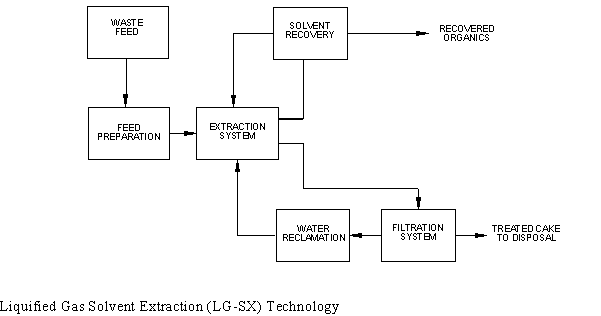
(Liquified Gas Solvent Extraction [LG-SX] Technology)
The CF Systems Corporation (CF Systems) liquified gas solvent extraction (LG-SX) technology uses liquified gas solvents to extract organics from soils, sludges, sediments, and wastewaters. Gases, when liquified under pressure, have unique physical properties that enhance their use as solvents. The low viscosities, densities, and surface tensions of these gases result in significantly higher rates of extraction compared to conventional liquid solvents. These enhanced physical properties also accelerate treated water's gravity settling rate following extraction. Due to their high volatility, gases are also easily recovered from the suspended solids matrix, minimizing solvent losses.
Liquified propane solvent is typically used to treat soils, sludges, and sediments, while liquified carbon dioxide is typically used to treat wastewater. The extraction system uses a batch extractor-decanter design for solids and sludges and a continuous trayed tower design for waste-waters and low-solids wastes. Typical treatment costs for non-pumpable soils and sludges range from $80 to $300 per ton of feed, excluding excavation and disposal.
Contaminated solids, slurries, or wastewaters are fed into the extraction system along with solvent (see figure below). Typically, more than 99 percent of the organics are extracted from the feed. After the solvent and organics are separated from the treated feed, the solvent and organic mixture passes to the solvent recovery system. Once in the solvent recovery system, the solvent is vaporized and recycled as fresh solvent. The organics are drawn off and either reused or disposed of. Treated feed is discharged from the extraction system as a slurry. The slurry is filtered and dewatered. The reclaimed water is recycled to the extraction system and the filter cake is sent to disposal or reused.

The LG-SX technology can be applied to soils and sludges containing volatile and semivolatile organic compounds and other higher boiling point complex organics, such as polynuclear aromatic hydrocarbons (PAH), polychlorinated biphenyls (PCB), dioxins, and pentachlorophenol (PCP). This process can also treat refinery wastes and wastewater contaminated with organics.
This technology was accepted into the SITE Demonstration Program in 1988. Under the SITE Program, a pilot-scale mobile demonstration unit was tested in September 1988 on PCB-laden sediments from the New Bedford Harbor Superfund site in Massachusetts. PCB concentrations in the harbor sediment ranged from 300 parts per million (ppm) to 2,500 ppm. The Technology Evaluation Report (EPA/540/5-90/002) and the Applications Analysis Report (EPA/540/A5-90/002) are available from EPA.
A pilot-scale treatability study was completed on PCB-contaminated soil from a Michigan Superfund site. Analytical data showed that the treatment reduced PCB levels to below 5 ppm, representing a 98 percent removal efficiency for this waste. A Project Summary (EPA/540/SR-95/505), which details results from this work, is available from EPA.
CF Systems completed the first commercial on-site treatment operation at Star Enterprise in Port Arthur, Texas. The propane-based solvent extraction unit processed listed refinery K- and F-wastes, producing Resource Conservation and Recovery Act treated solids that met EPA land-ban requirements. The unit operated continuously from March 1991 to March 1992 and was on-line more than 90 percent of the time. Following heavy metals fixation, the treated solids were disposed of in a Class I landfill.
EPA Region 6 and the Texas Natural Resources Conservation Commission selected the LG-SX technology to clean an estimated 115,000 tons of contaminated soil at the United Creosoting Superfund Site in Conroe, Texas. The 250 tons per day unit is on site and is anticipated to begin full scale operation in December 1996. The soil is contaminated with PAHs, PCP, and chlorinated isomers of furan and dioxin.
This technology was demonstrated concurrently with dredging studies managed
by the U.S. Army Corps of Engineers. Contaminated sediments were treated
by the LG-SX technology, using a liquified propane and butane mixture as
the extraction solvent. The demonstration at the New Bedford site yielded
the following results:
EPA PROJECT MANAGER:
Mark Meckes
U.S. EPA
National Risk Management Research Laboratory
26 West Martin Luther King Drive
Cincinnati, OH 45268
513-569-7348
Fax: 513-569-7328
TECHNOLOGY DEVELOPER CONTACT:
L.V. Benningfield
CF Systems Corporation
18300 West Highway 72
Arvada, CO 80007
303-420-1550
Fax: 303-420-2890